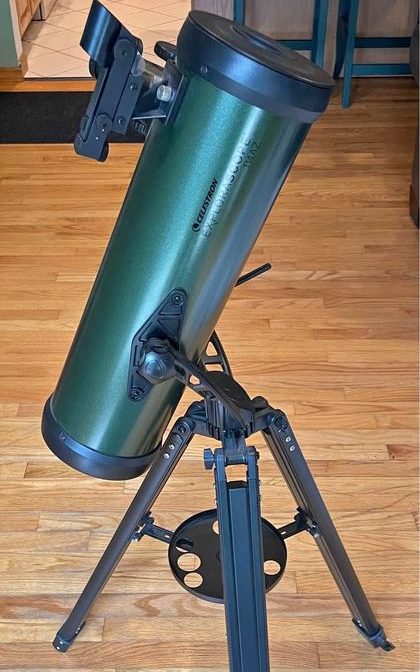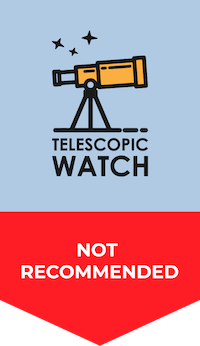The Optical Tube
The Celestron ExploraScope 114AZ is a Bird-Jones 114mm f/8.8 – identical to the Celestron AstroMaster 114 and 114LCM. These scopes are very difficult to collimate, and even when collimated, the images fall short of being sharp. They’re based on Newtonian reflectors but have a poorly designed and poorly manufactured corrector lens to fix the aberrations caused by their flawed spherical primary mirrors. It’s a nice design on paper, but Celestron’s implementation of the Bird-Jones design makes for a poor-quality scope with mushy images at best and unusable ones at worst.

Disturbingly, the ExploraScope manual neither tells one about the existence of collimation, nor how to do it, nor that the 114AZ needs it.
The focuser on the 114AZ is a usable 1.25” rack-and-pinion unit made almost entirely out of plastic. It could probably use an additional shim or two on the drawtube as it seems to wobble a little during use, but it’s functional as-is and this modification is very cheap and easy to do yourself.
Reviewing the Supplied Accessories
Like the AstroMaster and PowerSeeker Newtonians, the ExploraScope 114AZ comes with a 20mm erecting eyepiece of a Kellner-like design, a 4mm Ramsden eyepiece that is of low quality and provides too much power for the scope to handle, and an outrageously bad 3x Barlow lens made entirely of plastic.
Of these, only the 20mm is usable, and it is not a great eyepiece – the cheap erecting design and low-quality coatings result in a lot of light loss and dim images as a result; the field of view is quite narrow at maybe 35 degrees or so, and the 50x it provides is a little much for a low-power eyepiece. The eyepiece also results in even fuzzier images than what is already provided by the Bird-Jones optics.
A 32mm or 25mm Plossl would be an order of magnitude better than the 20mm erecting eyepiece, as would a decent Plossl or even a Kellner eyepiece for higher magnification. This stupid “erecting” eyepiece design is provided solely for the function of advertising the scope for terrestrial viewing, because Celestron has a habit of marketing their cheap scopes at “nature/science” stores and other places where the consumer’s knowledge is basically limited to what the scope says on the box.
The StarPointer red dot included with the ExploraScope is ideal for such an instrument and works well. You can easily detach and reattach it with the two hand knobs that are provided if needed for transport.
Lastly, the ExploraScope is offered with a smartphone adapter that grips your phone and eyepiece and has adjustments to centre your phone’s camera. You can take some relatively sophisticated lunar photos with these, but the planets are difficult to shoot without a mount with tracking and a CCD/CMOS camera or DSLR would be arguably better for such a task.
AltAz Mount
The ExploraScope mount is an alt-azimuth fork design on a lightweight (but sturdy) extruded aluminium tripod. Due to the way these mounts operate and the scopes they are designed for (long refractors), it is rather hard to get the desired fine motion capability with a very short optical tube like the Celestron ExploraScope 114AZ, but it does work acceptably. It’s nowhere near as good as a Dobsonian or a good equatorial mount, however, and is likely to result in a lot of frustration when trying to keep the scope aimed at a target at high magnification.
Should I buy a used Celestron ExploraScope 114?
Unless it’s free, you really shouldn’t bother with a used Celestron ExploraScope. It’s not worth much of anything.
Aftermarket Accessory Recommendations
Despite the cost, which could, of course, go towards upgrading to a better telescope, quality aftermarket eyepieces can at least allow the observational experience with your ExploraScope 114AZ to be somewhat enjoyable, despite its imperfect optics. A 32mm Plossl (31x) yields the broadest possible field of view with the scope and is perfect for observing deep-sky objects, though it will display slight vignetting due to the Bird-Jones corrector lens, while a 15mm “redline” or “goldline” eyepiece (67x) should still be capable of producing sharp images and unveiling some planetary details without exceeding the limitations of the ExploraScope’s optics. You can also use these eyepieces with a better telescope in the future.
What can you see with the Celestron ExploraScope 114AZ?
The Celestron ExploraScope 114AZ is far from being a particularly good telescope, but if you make some serious effort to get the thing collimated and are understanding of its limitations, there’s still a fair amount to see.
- The Moon still looks fairly good and will amaze a beginner even with a poorly-collimated instrument.
- Mercury’s phases are likely to be difficult to spot with the ExploraScope 114AZ.
- Venus’ phases should be easy.
- Mars is likely to be a red dot devoid of detail. During the few months when Mars is close to Earth every two years, a properly collimated 114AZ may just barely be able to show you an ice cap and a dark marking or two.
- Jupiter’s moons are easily visible, along with the planet’s two main cloud belts. The Great Red Spot and the brown polar zones are more difficult to see, but they are possible to see.
- Saturn’s rings are visible, and its largest moon, Titan can be seen. Cloud belts on the planet itself are tricky, as are the other bright moons (Rhea is the easiest of the bunch). The Cassini division is probably not visible due to the 114AZ’s poor optical quality.
- Good luck finding Uranus and Neptune, let alone distinguishing them from stars.
- Globular star clusters are fuzzy balls with maybe the tiniest hint of graininess.
- Open star clusters are pretty, though the stars are less-than-sharp and could be framed better with the wider fields of view possible with faster (and better) tabletop Dobsonians.
- Bright nebulae such as Orion and the Lagoon look quite good, especially under fairly dark skies.
- Planetary nebulae are largely out of reach with the 114AZ, with a few exceptions. The ring is tiny but bright, the dumbbell is fairly large but dim, and most others are likely to be invisible or unrecognisable.
- Galaxies are simply too small and dim to be of much interest in any 4-inch telescope, let alone one with poor optics like the 114AZ. You’ll be lucky to see the brighter Messier catalogue galaxies and maybe the dust lane in M31.


